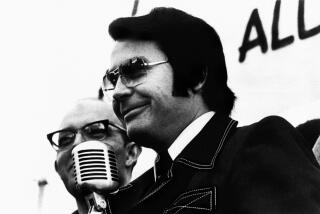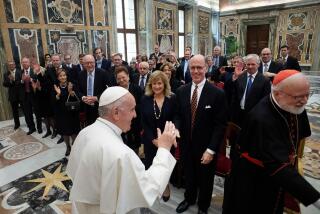Religious Revivals of Limited Value : Rallies like the Harvest Crusade and Pope John Paul II’s visit are more about feeling good than doing good.
Last month’s Harvest Crusade at Anaheim Stadium and the Pope’s mid-August visit to Denver had much in common. Both targeted youth, both employed contemporary musical styles to create the ambience for memorable evangelism, both warned of the dangers of secular culture with its disregard for traditional morality. Yet, one wonders whether religious revivals are a cure for our aching world or a symptom of our distress.
Harvest Crusade, the Evangelical Protestant version of a religious happening, hearkens back to the 1733 sermons of New England preacher Jonathan Edwards who was disturbed by moral corruption--particularly among young people. The sermons ignited a fire; revivalism American style was born. This “hot gospel” tradition in our century alone has given us Billy Sunday, Aimee Semple McPherson, Oral Roberts, Billy Graham and scores of others.
The Pope’s encounter with a half-million Catholic young people at an event he himself launched--World Youth Day--is rooted in the Catholic tradition of a pilgrimage to a holy site. Rome, where the relics of Peter and Paul reside in St. Peter’s Basilica, is such a place. And huge crowds gather in St. Peter’s Square for papal audiences, for encounters with a man who represents holiness.
Catholic pilgrims also throng to Lourdes in France, Fatima in Portugal and Guadalupe in Mexico because they believe the Virgin Mary appeared there. Denver is not a holy place, but the Bishop of Rome and the holiness he symbolizes had decided to come there. So the cream of the world’s Catholic youth made a pilgrimage to Denver.
Both the Harvest Crusade and the papal visit were profoundly moving experiences for many of their youthful participants. It is not surprising that evangelists Greg Laurie and Chuck Smith and Pope Paul II would want to appeal to youth, to those who represent the world’s future. Parents, teachers and preachers have always done so.
But our times are different. We are experiencing an epidemic of youth crime and mayhem, with the teen crime rate growing faster than among any other age group. There are about as many gang members in greater Los Angeles as there are citizens in Tustin--60,000!
The Children’s Defense Fund provides grim figures that may partially explain the causes of this plague of teen-age lawlessness. Every day in America 7,000 children are reported abused or neglected and 2,800 are born into poverty; eight million have no health insurance; 100,000 go to bed homeless each night.
But the problem is not unique to poverty-stricken youth. We have seen ample crime in the suburbs as well. A child psychiatrist recently told me that what struck him about today’s teens compared to those of several years ago is the hopelessness he perceives in them. Many just don’t see that the future holds anything for them.
Those attending revivals are concerned about the severity of the problems among our youth. However, people go to revivals principally for inspiration and reassurance that God cares for them--not for making the world a better place for the young (or for humanity generally). In other words, revivals are more about feeling good than doing good, about being saved than helping save the globe.
There are ways to begin confronting the crisis of contemporary youth that move beyond rallies and revivals. They center on efforts by citizens of conscience who try to touch and inspire young people.
One approach is the Santa Ana School District’s Stay in School Program which matches an eighth or 10th-grade class with a two-person team from the community. The mentors come from a variety of careers, but all are individuals who valued an education enough to stick to it and make something of themselves. They visit their adopted class for 45 minutes six times a semester; they share their stories, answer questions, and provide cheerleading for kids who really need it. The result: a significant decrease in the drop-out rate.
Another approach is that of several area synagogues and churches in the county that have adopted an elementary or middle school in a poorer district. Members of the synagogue or church provide extras, such as computers and reference books, do tutoring and mentoring, and arrange exchange programs between their children and those from the adopted school.
Finally, there is the program at a Jewish retirement home in Los Angeles that matches a resident with a child whose grandparents live in another part of the country or are deceased. Foster grandparenting is good for all concerned.
It is worth noting that volunteerism is perhaps as deeply rooted in the American religious psyche as revivalism. Volunteer efforts of the sort just described are far from the whole solution to our youth crisis. But what a stunning difference it would make if more people did something concrete to care for our young and thus for the world’s future.
More to Read
Sign up for Essential California
The most important California stories and recommendations in your inbox every morning.
You may occasionally receive promotional content from the Los Angeles Times.










